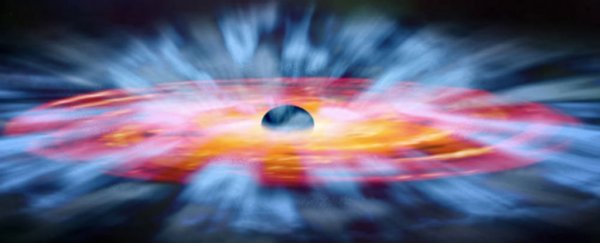Physicists in the US think they've solved one of the biggest mysteries around black holes: how to retrieve information from them.
The gravity inside a black hole is so strong that even light can't escape, and according to theory, nor can any data about the quantum particles that end up inside. That's a problem for scientists, as it makes it impossible to predict the exact evolution of the black hole, and what's actually going on inside it. Plus the theory of quantum physics states that no information about the Universe can ever be totally lost, so what's going on?
Researchers at the California Institute of Technology (Caltech) think that by using a strategy similar to quantum teleportation, information about one quantum bit (qubit) can be retrieved - that's not a lot of data, but it's a start. As long as enough measurements and observations have been carried out on the black hole ahead of time, it should be possible to pick out this qubit's state.
Their paper relies on Stephen Hawking's theory of black hole radiation, which states that a black hole gradually evaporates away as it reduces in size. While it was originally believed that this radiation is formed of nothing but heat, scientists have come around to the idea that it contains information about the black hole's contents too.
And now this new hypothesis suggests that every particle that falls into a black hole can be measured via a linked particle on the other side of the event horizon - the boundary of the black hole.
As Adrian Cho explains at Science magazine, imagine a quantum teleportation scenario involving two particles called Alice and Bob. Electrons can have a quantum state of spinning up, down, or both ways at once, and Alice wants to transfer the state of her electron to Bob. But without some other forces at play, this is impossible, because as soon as a particle's state is measured, it collapses and cannot be transferred.
That's where the idea of quantum entanglement comes in - Alice and Bob have an extra 'entangled' pair of electrons, the states of which are locked together (one must be spinning up and one must be spinning down). By projecting two unentangled electrons onto the entangled pair that Alice and Bob share, Bob's electron changes state and thus reflects whatever state Alice's electron was originally set to.
The end result of all that complicated quantum physics is that by studying one particle in a particular way, we should be able to get information about the state of another one linked to it. By capturing and observing an entangled pair of particles (one inside and one outside), our friend Alice can see the state of the internal one transferred to the external one, propose the Caltech scientists.
As with much of the work around black holes, it's only an hypothesis for now - one which has met criticism - but it provides a starting point which may help researchers understand more about how black holes function.
"It could be that the information is preserved in the state of the leftover Hawking radiation, albeit highly scrambled and difficult to distinguish from a thermal state," writes lead researcher Aidan Chatwin-Davies at the Preposterous Universe blog. "Under very modest and special circumstances, you can toss one qubit into a black hole and then recover its state, and hence the information that it carried."
The researchers are publishling their hypothesis in Physical Review Letters (in press), and have also published it online at arXiv.org.
